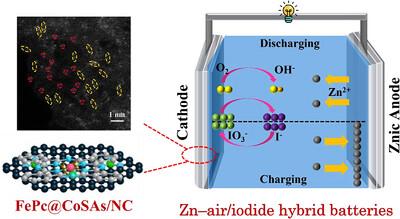铁酞菁偶联钴单原子双活性位锌-空气/碘化混合电池的高能效研究
IF 19
1区 材料科学
Q1 CHEMISTRY, MULTIDISCIPLINARY
引用次数: 0
摘要
可充电锌空气电池(ZABs)存在较大的电压滞后和有限的循环稳定性。为了应对这些挑战,通过协同电解质工程和催化剂设计开发了双重创新策略。首先,电解质工程通过将KI掺入电解质中来实现,将传统的ZABs转变为锌-空气/碘化物混合电池(ZAIHBs)。这种修饰用碘氧化反应(IOR)取代了析氧反应(OER),该反应在过电位显著降低的情况下运行。其次,将酞菁铁(FePc)锚定在Co单原子/ n掺杂碳基体上,构建FePc@CoSAs/NC催化剂。FePc@CoSAs/NC显示ORR的半波电位为0.89 V, IOR在10 mA cm - 2时达到1.26 V, ORR/IOR电压间隙为0.37 V,创历史新低。优化后的zaihb具有75%的能效和73.5%的循环稳定性,优于传统的zab。密度泛函理论计算表明,Co-Fe双配位优化了关键反应中间体(ORR中的OH*和IOR中的I*)的吸附能量,阐明了增强的反应动力学。这项工作通过集成电解质和催化剂工程建立了高性能混合能源系统的协同设计范例。本文章由计算机程序翻译,如有差异,请以英文原文为准。

High Energy Efficiency on Zn–Air/Iodide Hybrid Batteries with Iron Phthalocyanine Coupled Co Single Atoms Dual Active Sites
Rechargeable zinc–air batteries (ZABs) are hindered by substantial voltage hysteresis and limited cycling stability. To address these challenges, a dual-innovation strategy is developed through synergistic electrolyte engineering and catalyst design. First, electrolyte engineering is implemented through the incorporation of KI into the electrolyte, transforming conventional ZABs into zinc–air/iodide hybrid batteries (ZAIHBs). This modification replaces the oxygen evolution reaction (OER) with the iodine oxidation reaction (IOR), which operates at a significantly reduced overpotential. Second, FePc@CoSAs/NC catalyst is constructed by anchoring iron phthalocyanine (FePc) on Co single-atom/N-doped carbon substrates. FePc@CoSAs/NC exhibiting a half-wave potential of 0.89 V for ORR and achieving 1.26 V at 10 mA cm−2 for IOR with a record-low ORR/IOR voltage gap of 0.37 V. The optimized ZAIHBs demonstrate exceptional energy efficiency of 75% and cycling stability (73.5% retention over 350 h), surpassing conventional ZABs. Density functional theory calculations reveal that the Co–Fe dual-site coordination optimizes adsorption energetics for critical reaction intermediates (OH* in ORR and I* in IOR), elucidating the enhanced reaction kinetics. This work establishes a co-design paradigm for high-performance hybrid energy systems through integrated electrolyte and catalyst engineering.
求助全文
通过发布文献求助,成功后即可免费获取论文全文。
去求助
来源期刊

Advanced Functional Materials
工程技术-材料科学:综合
CiteScore
29.50
自引率
4.20%
发文量
2086
审稿时长
2.1 months
期刊介绍:
Firmly established as a top-tier materials science journal, Advanced Functional Materials reports breakthrough research in all aspects of materials science, including nanotechnology, chemistry, physics, and biology every week.
Advanced Functional Materials is known for its rapid and fair peer review, quality content, and high impact, making it the first choice of the international materials science community.
 求助内容:
求助内容: 应助结果提醒方式:
应助结果提醒方式:


